Peer into the Sea of Tiberias' biblical tales, where miracles unfold and faith's depth is explored, beckoning a deeper reflection on its timeless stories.
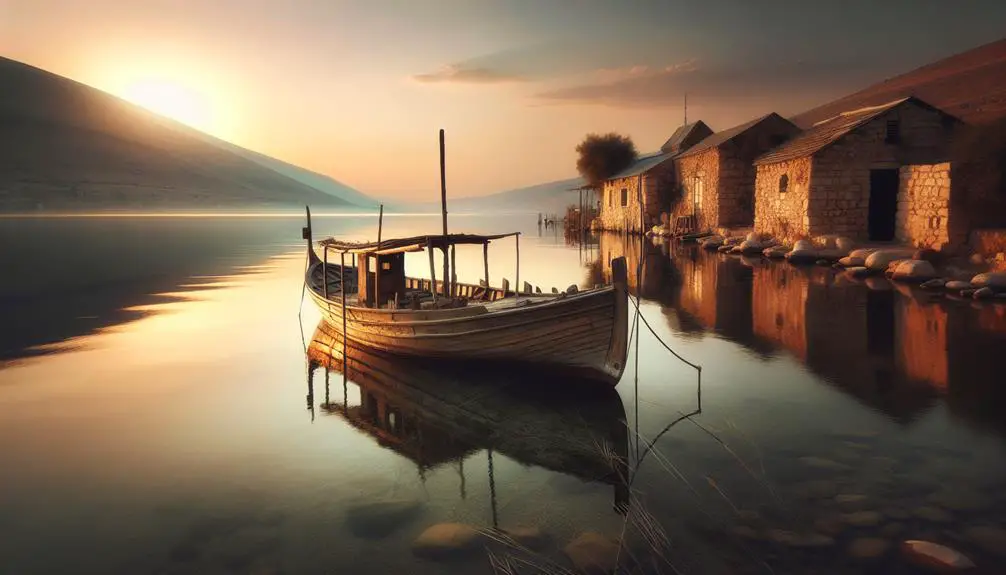
Sea of Tiberias in the Bible
In the serene yet tumultuous pages of the Bible, the Sea of Tiberias stands as a silent witness to miracles and teachings that continue to shape beliefs today. You've likely heard its tales of walking on water and miraculous catches of fish, but have you considered its deeper significance?
As you explore this ancient body of water's role, you'll uncover layers of meaning that go beyond mere events, touching on the essence of faith, hope, and renewal. Why does this matter to you? Well, understanding its historical and geographical context might just offer you a new perspective on familiar stories, prompting a reflection on their place in your own life.
Key Takeaways
- The Sea of Tiberias is central to many New Testament events, including Jesus' miracles and teachings.
- It served as a crossroads for various cultures, enriching biblical narratives with diverse influences.
- Disciples' transformative encounters with Jesus on the sea symbolize key spiritual lessons on faith and discipleship.
- Today, it attracts visitors for its biblical significance and faces challenges in ecological conservation and cultural preservation.
Biblical References
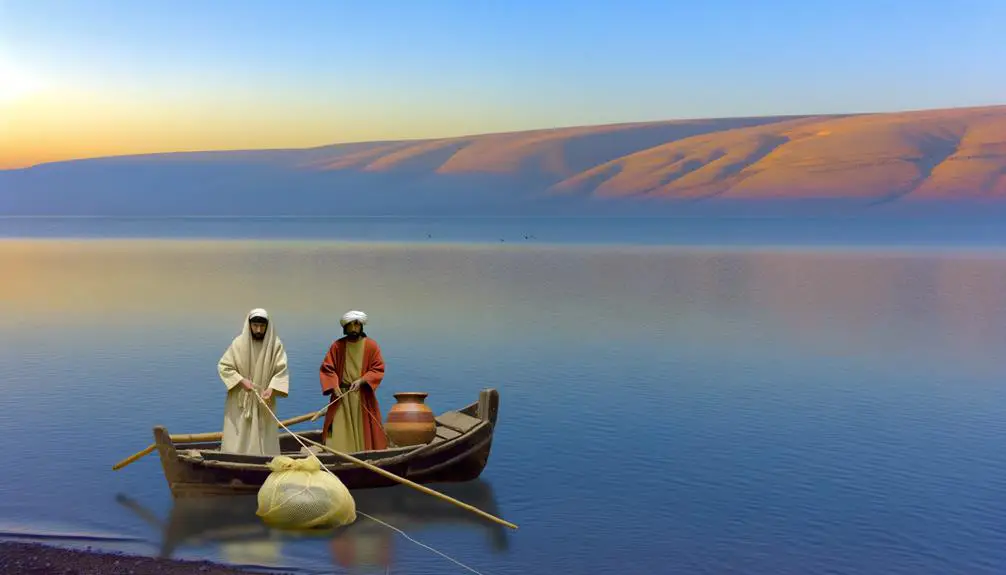
Throughout the New Testament, the Sea of Tiberias serves as a pivotal backdrop for numerous events and teachings in the ministry of Jesus. Understanding its significance requires delving into the cultural context of the time and examining the Apostle journeys that intersect at this locale. The Sea of Tiberias, also known as the Sea of Galilee, wasn't just a body of water but a hub of economic, social, and religious activity. Its shores were dotted with towns and villages, making it a focal point for the local communities.
The Apostle journeys, as chronicled in the Scriptures, often led through or around this sea, underscoring its importance as a thoroughfare and a place of encounter. Jesus' selection of disciples from among the fishermen of Galilee, for instance, speaks volumes about the sea's role in daily life and livelihoods. It was here that Jesus interacted with individuals from various walks of life, imparting teachings that have resonated through the ages.
Moreover, the cultural context of the Sea of Tiberias is integral to understanding the narratives that unfold in its vicinity. The sea was a crossroads of cultures, where Jewish traditions met with Greco-Roman influences, creating a dynamic setting for the ministry of Jesus. This blending of cultures and communities at the Sea of Tiberias provided a rich tapestry against which Jesus' teachings and actions took on added dimensions, making it a critical component of the biblical narrative. Engaging with the Sea of Tiberias through this lens allows for a deeper appreciation of its role in the New Testament.
Miracles Performed
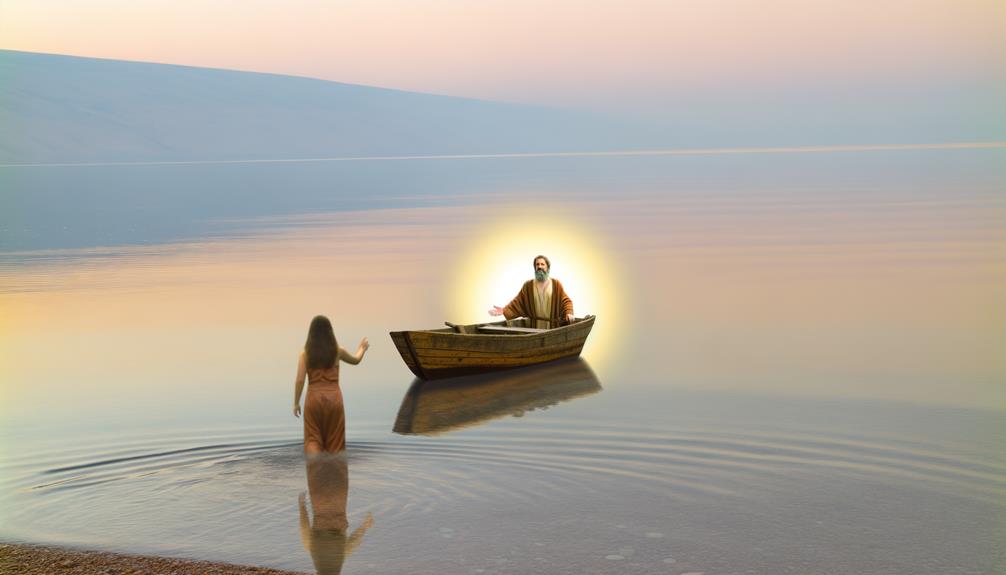
Exploring the Sea of Tiberias further, we encounter the extraordinary miracles performed by Jesus, pivotal moments that underscore his divinity and the profound impact on those who witnessed them. These events, rooted deeply in Christian faith, aren't just narratives of wonder but also carry theological significance, illustrating Jesus' mastery over nature and his compassion through acts of faith healing.
- Walking on Water: Defying natural laws, Jesus walked on the waters of the Sea of Tiberias, demonstrating his dominion over creation and offering a profound lesson in faith to his disciples.
- Calming the Storm: With mere words, Jesus calmed a violent storm on the sea, showcasing his power over the elements and providing a tangible sign of his protective care for his followers.
- Multiplication of the Loaves and Fishes: Near the Sea of Tiberias, Jesus miraculously fed thousands with only five loaves and two fish, highlighting his concern for physical needs and his ability to provide abundantly.
- Water Transformation: Although not directly on the Sea of Tiberias, the transformation of water into wine at Cana parallels his command over the natural world, underscoring the theme of transformation central to his ministry.
- Faith Healing: Along the shores, numerous instances of faith healing occurred, where the sick and afflicted were restored, emphasizing Jesus' compassion and the power of faith.
These miracles, performed in and around the Sea of Tiberias, aren't merely acts of divine power but serve as foundational teachings on faith, divine authority, and compassion, offering insights into the character and mission of Jesus.
Jesus' Teachings by the Shore
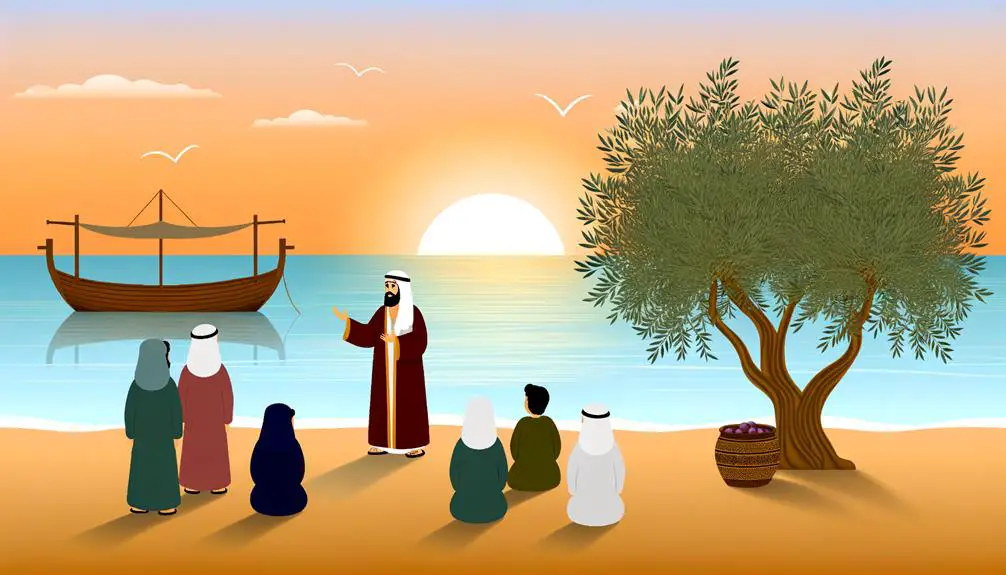
By the serene shores of the Sea of Tiberias, Jesus imparted teachings that resonated deeply with his followers, offering profound insights into the nature of the Kingdom of God. This setting, a tranquil backdrop juxtaposed with the potency of his messages, created a unique atmosphere for the dissemination of his teachings. Through crowd teachings and parable delivery, Jesus utilized the natural surroundings to illustrate spiritual truths, making the abstract tangible for his audience.
The crowd teachings by the Sea of Tiberias were significant not just for their content but for their method of delivery. Jesus' choice of location was strategic, allowing his voice to carry over the water, reaching large numbers of people gathered to hear him. This natural amplification facilitated the spread of his teachings, demonstrating an adept understanding of his environment to maximize the impact of his message.
Moreover, the parable delivery by the shore served as a powerful pedagogical tool. Parables, by their nature, require contemplation and interpretation. By embedding these stories with the familiar context of nature and everyday life, Jesus ensured that his teachings were accessible yet profound, inviting listeners to delve deeper into their spiritual exploration. These stories, set against the backdrop of the Sea of Tiberias, became vivid illustrations of moral and spiritual principles, engaging the listeners' senses and imagination.
In this way, the teachings of Jesus by the Sea of Tiberias weren't only theological discourses but also immersive experiences that utilized the natural world as a canvas for spiritual enlightenment. This approach underscored the interconnectedness of the physical and spiritual realms, reinforcing the depth and accessibility of divine truth through the beauty of creation.
Historical Significance
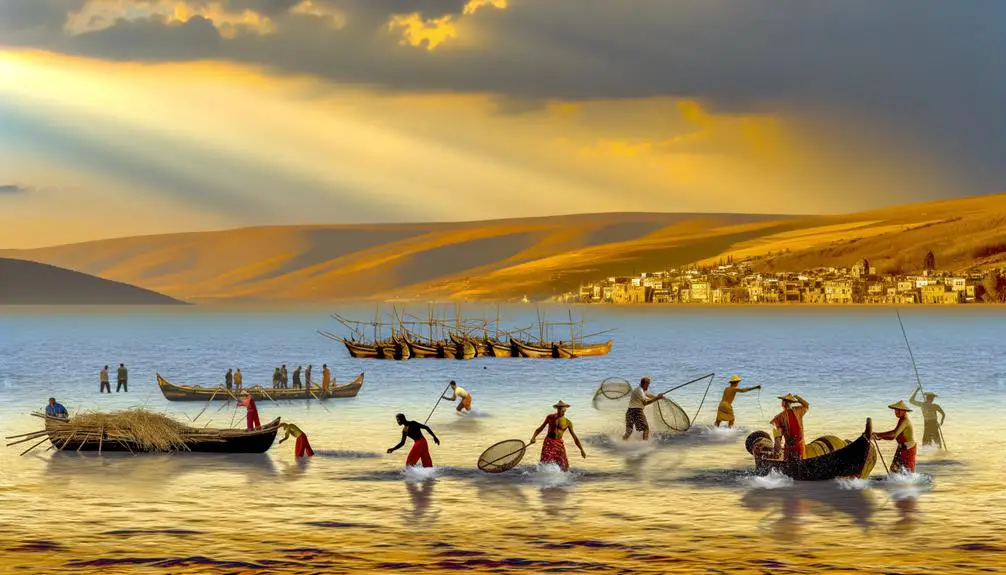
The Sea of Tiberias' historical significance extends beyond its biblical mentions, serving as a pivotal location in the broader narrative of ancient Near Eastern history. You'll find that this ancient lake wasn't just a backdrop for spiritual teachings but also a crossroads of cultures, trade, and political power throughout centuries. The archaeological findings and cultural impact of this region are profound, revealing layers of human history and interaction that have shaped the world in innumerable ways.
To understand the depth of its historical significance, consider these key points:
- Archaeological Findings: Excavations around the Sea of Tiberias have unearthed artifacts that span millennia, offering glimpses into the lives of those who lived here. From ancient boats to remnants of settlements, these findings tell stories of commerce, conflict, and community.
- Cultural Impact: The lake's shores have witnessed the mingling of diverse cultures, from Jewish and Roman to Byzantine and Islamic. Each left its mark, contributing to a rich tapestry of cultural heritage.
- Strategic Importance: Its location made it a vital trade route, connecting the region with broader trade networks across the Middle East.
- Religious Significance: Beyond Christianity, the area has been significant for Jewish and Islamic traditions, hosting historical figures and events critical to these faiths.
- Economic Role: The Sea of Tiberias was central to the local economy, supporting fishing, agriculture, and trade throughout ancient times.
In analyzing the Sea of Tiberias, you're peeling back layers of history, uncovering the profound interconnections between geography, culture, and human endeavor.
Geographical Overview
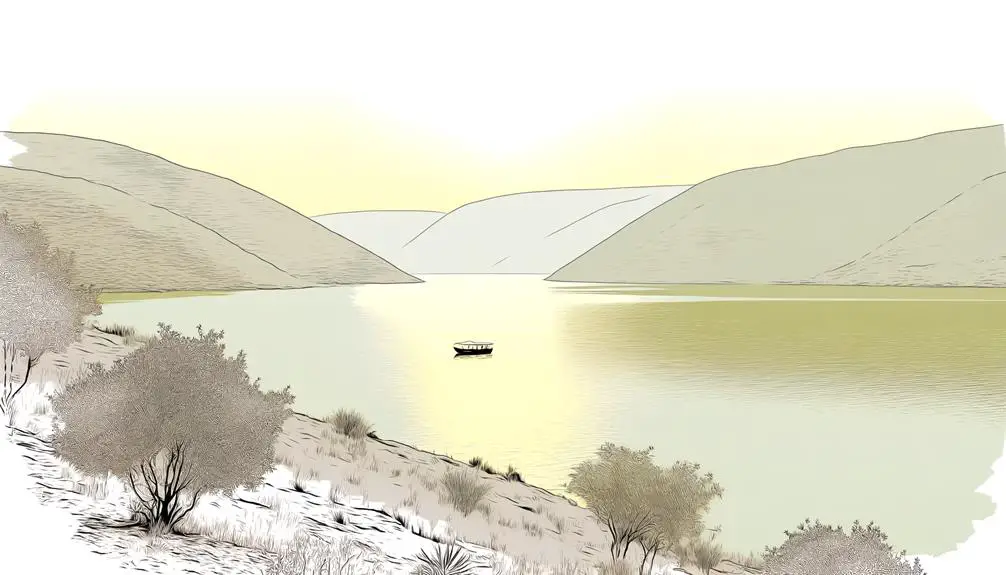
You'll find the Sea of Tiberias, also known as the Sea of Galilee, situated in the northeastern region of Israel, embodying a significant freshwater source for the surrounding areas.
Its dimensions and strategic location have played pivotal roles in both historical and biblical contexts, influencing the cultural and socio-economic interactions within the region.
Understanding its geographical setting provides crucial insights into the narratives and events documented in the Bible, connecting physical landscapes with spiritual significance.
Location and Size
Situated in the northeastern region of Israel, the Sea of Tiberias, also known as the Sea of Galilee, spans an area of approximately 166 square kilometers, making it the largest freshwater lake in the country.
As you delve into its geographical nuances, consider these critical aspects:
- Water depth: Averages around 25.6 meters, with deeper sections reaching up to 43 meters.
- Ecological status: It's a vibrant ecosystem supporting a variety of aquatic life.
- Climate influence: Governed by a unique microclimate, affecting water levels and biodiversity.
- Geological formation: Result of tectonic activity, nestled within the Jordan Rift Valley.
- Human impact: Subject to water management practices influencing its ecological balance.
Understanding its location and size offers a foundation for appreciating its significance, both historically and ecologically.
Historical Significance
Delving into its historical significance, the Sea of Tiberias emerges as a pivotal geographical entity in ancient narratives, shaping the cultural and socio-economic landscapes of the region. Archaeological findings around the Sea of Tiberias have unveiled a rich tapestry of human activity, highlighting its cultural influence on surrounding communities. From ancient fishing techniques to religious rituals, the evidence gathered provides a window into the everyday lives of those who once thrived along its shores.
Aspect |
Impact |
Examples |
|---|---|---|
Archaeological |
Unveils human activity & settlement patterns |
Ancient harbors, boats |
Cultural Influence |
Shapes regional beliefs & practices |
Religious rituals, festivals |
Socio-Economic |
Drives trade & sustenance |
Fishing, trade routes |
These elements collectively underscore the sea's enduring legacy in shaping human history and culture.
Disciples' Encounters
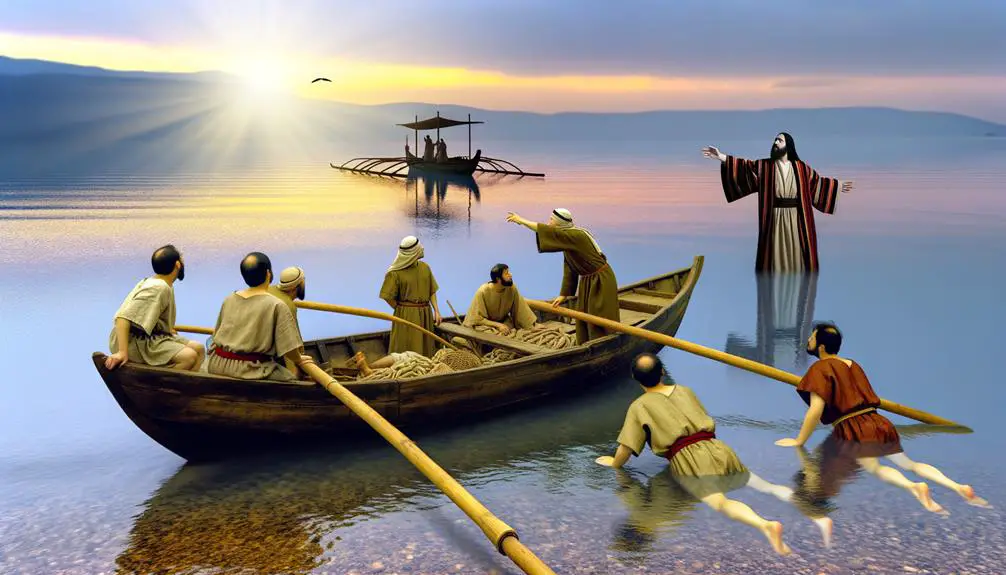
You'll find that the Sea of Tiberias serves as the backdrop for pivotal moments in the disciples' spiritual journey, notably the Miraculous Catch of Fish and Jesus Walking on Water. These events not only underscore the sea's importance in biblical narratives but also illuminate the profound, transformative encounters between Jesus and his followers.
Analyzing these occurrences provides insight into the nature of faith and discipleship in the early Christian community.
Miraculous Catch of Fish
In the context of the Sea of Tiberias, the Miraculous Catch of Fish stands as a pivotal event where Jesus' disciples experience a profound demonstration of divine provision and authority. This narrative isn't only rich in symbolism but also offers insights into:
- The reliance on traditional fishing techniques of the era
- The economic impact of such a significant catch on local fishermen
- The transformative power of faith in altering one's circumstances
- The disciples' growing awareness of Jesus' divine nature
- The reinforcement of fishing as a metaphor for their future mission
Analyzing this event, you'll find a deep intersection of faith, livelihood, and the dawn of a new understanding of Jesus' role in the lives of the disciples and, by extension, in the broader socio-economic context of the time.
Jesus Walks on Water
Another remarkable episode in the disciples' journey alongside Jesus is when He demonstrated His command over nature by walking on the waters of the Sea of Tiberias.
Aspect |
Analysis |
|---|---|
Faith Symbolism |
Jesus' act of walking on water symbolizes the transcendence over physical laws through faith. It challenges you to trust beyond what's visible or understandable. |
Disciples' Reaction |
Initially, they're terrified, mistaking Jesus for a ghost. This highlights humanity's struggle to recognize divine interventions amidst fear. |
Weather Control |
The calm that follows Jesus' command over the stormy sea signifies His authority over natural elements, reinforcing His divinity. |
Peter's Attempt |
Peter's walk towards Jesus and subsequent sinking symbolizes faltering faith but also the grace of salvation. |
Teaching Moment |
This event serves as a profound lesson in faith, courage, and the recognition of Jesus' divine nature. |
This narrative invites you to reflect deeply on the dimensions of faith and divine authority.
Modern-Day Importance
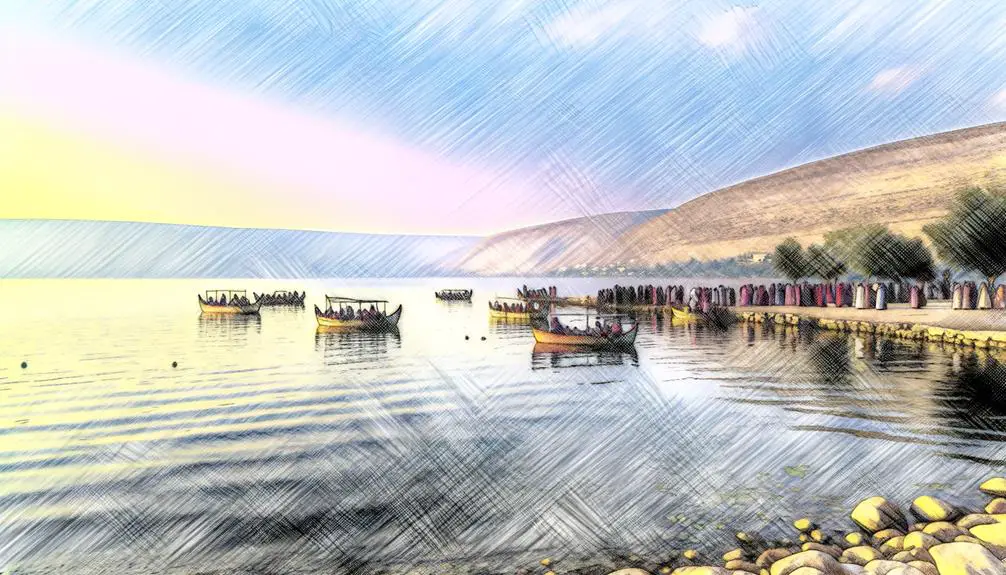
Why does the Sea of Tiberias hold enduring significance in our contemporary world?
At first glance, you might see it merely as a historical and religious landmark, but its importance extends far beyond. Today, it's a focal point where the past meets the present, where tradition intertwines with modernity, making it a unique site of global interest.
Analyzing its current relevance, one must consider both its tourism impact and the ecological challenges it faces.
- Tourism Impact: The Sea of Tiberias attracts millions of visitors annually, drawn by its biblical stories and serene beauty. This influx boosts the local economy but also demands sustainable management to preserve its historical and natural integrity.
- Ecological Challenges: The sea faces significant ecological pressures from overfishing, pollution, and water level fluctuations. These challenges require immediate attention to ensure its survival for future generations.
- Cultural Significance: Its rich history makes it a living museum, offering insights into ancient civilizations and religions that have shaped the world.
- Scientific Research: The area is a hub for archaeological and environmental studies, providing valuable data on climate change, historical ecology, and human impact on natural resources.
- Peace and Coexistence: The Sea of Tiberias is a shared resource that necessitates cooperation among neighboring countries, promoting peace and mutual respect.
Frequently Asked Questions
How Has the Name "Sea of Tiberias" Evolved Over the Centuries, and What Are Its Other Names in Different Cultures and Languages?
You're exploring how 'Sea of Tiberias' has transformed through time, focusing on historical etymology and linguistic variations. This body of water's name shifted across cultures, reflecting historical influences and geographical shifts.
It's known as Lake Kinneret in Hebrew, stemming from its harp-like shape. Arabic cultures call it Lake Tiberias, whereas in Greek and Roman texts, it appears as Lake Gennesaret.
Each name offers insight into the region's rich, layered history.
Are There Specific Environmental or Ecological Issues Affecting the Sea of Tiberias Today, and How Have These Issues Impacted Local Communities and Wildlife?
You might think the current environmental issues are recent, but they've been worsening over time. Climate change and water management are central concerns affecting the Sea of Tiberias today.
These challenges have led to water scarcity, impacting both local communities and wildlife significantly. The area's delicate ecosystem is at risk, with rising temperatures and erratic rainfall patterns exacerbating the situation.
It's a complex issue that requires immediate and sustained attention.
What Are Some of the Major Archaeological Discoveries Around the Sea of Tiberias That Have Contributed to Our Understanding of Ancient Civilizations and Biblical Times?
You've likely wondered how we learn about ancient civilizations. Major archaeological discoveries, through sophisticated excavation methodologies, have unearthed secrets of the past. Near this significant body of water, findings not only illuminate historical narratives but also biblical times.
The focus on artifact preservation ensures that these treasures endure, offering insights into ancient societies. These discoveries have fundamentally enhanced our understanding, bridging gaps between historical records and archaeological evidence.
How Has the Sea of Tiberias Been Depicted in Art, Literature, and Popular Culture Outside of Religious Texts, and What Influence Has It Had on Global Perceptions of the Region?
You've likely seen the Sea of Tiberias depicted in various forms of art, literature, and popular culture, stepping beyond its biblical associations.
These artistic interpretations and cultural festivals have played a pivotal role in shaping global perceptions of the region.
They've not only showcased the area's stunning beauty but also highlighted its rich historical and cultural significance, influencing how people worldwide view and appreciate this unique part of the world.
What Are the Economic Activities, Including Tourism, Fishing, and Agriculture, That Are Prevalent Around the Sea of Tiberias, and How Have They Shaped the Local Economy and Culture Over the Years?
You'd be intrigued to know that 60% of the area's economy thrives on tourism, largely due to its unique location.
Climate change, however, poses a significant threat, altering both water levels and local agriculture. Fishing, once the backbone, now competes with water sports as a major attraction, reshaping the cultural landscape.
These economic activities have woven a complex tapestry, highlighting the delicate balance between tradition and modernity in shaping the local economy and culture.
Conclusion
In conclusion, the Sea of Tiberias, a canvas painted with historical and spiritual significance, vividly encapsulates the essence of biblical narratives.
You've traversed its shores where miracles unfolded, teachings resonated, and disciples found their call.
Its geographical and historical contours haven't only shaped ancient faith journeys but continue to anchor modern spiritual quests.
Through scholarly lenses, you've unraveled its layers, discovering a site where past dialogues with present, inviting a deeper exploration of its enduring importance in biblical scholarship.


Sign up